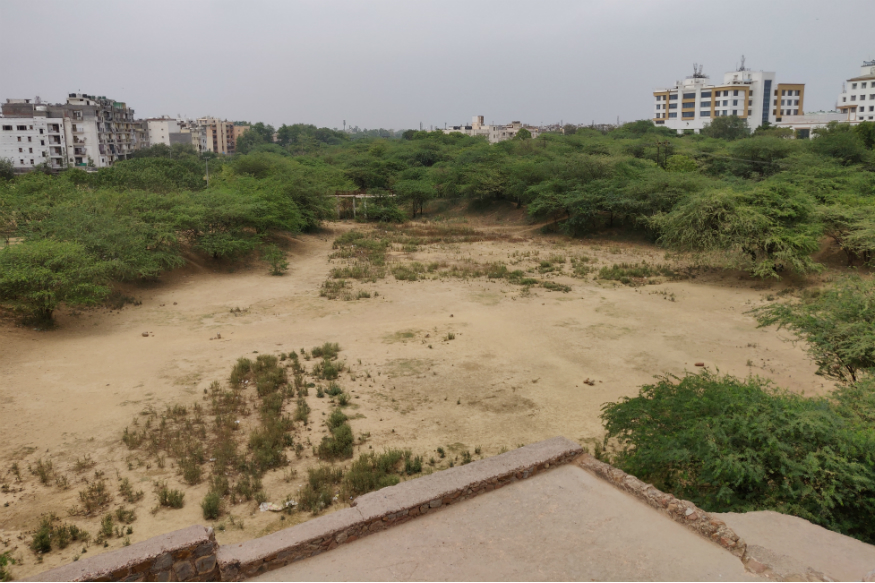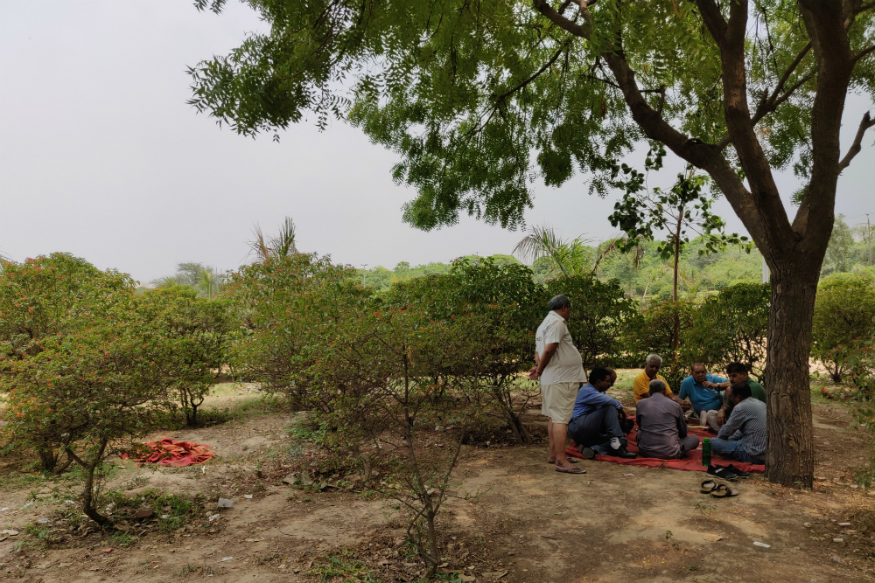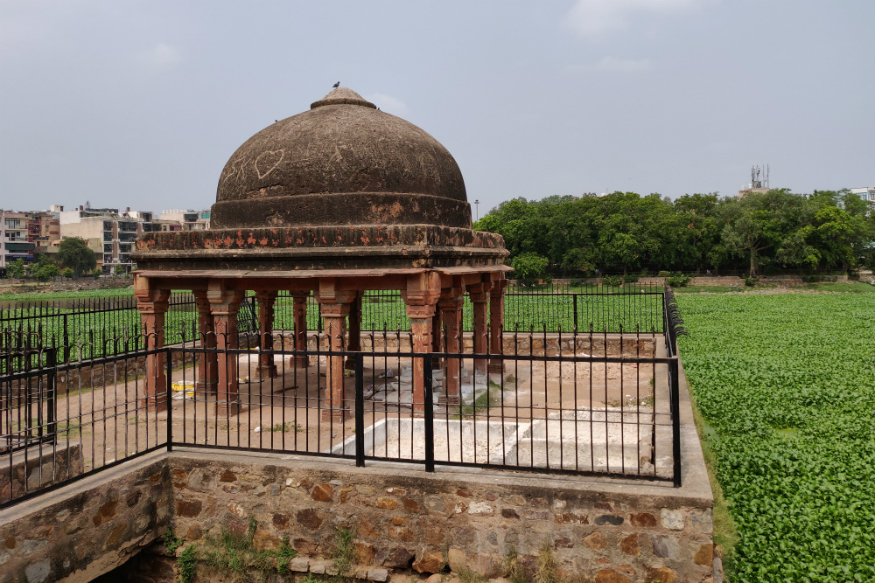New Delhi: In Delhi, the discourse on water is measured by a certain scale of nostalgia. The city’s plush area Hauz Khas was named after an ancient water reservoir by the same name. Centuries later the name remains, but the water bodies associated with it have disappeared; so has water.
Latha, 39, a resident of Khirki area in south Delhi, recalled the story of the now dry Satpula lake in a completely different memory. “My mother-in-law would tell us about a big lake behind the house where we now live. She told us about the farmers in the area who used it for irrigation. She showed us how children jumped into the lake for a bath,” she said.
“But where is the lake now? There is a sewer behind the house,” she said.
The Satpula is a manmade lake reportedly constructed around the 1300s. History has recorded its use as a dam at one point. But the lake’s original catchment area today has been reduced to include a children’s park, public gymnasium, benches and ample shade for romance.
Not far from where Latha lives, Natthu, a 35-year-old gardener, started residing in the 40-acre lake compound with his family seven months ago.
Natthu said he has never seen the lake filled with water. “I water the garden every day with the help of the installed borewell pump and a network of pipes. The borewell is what feeds both my family and the grass. I have only heard stories of water here,” he said.
Amid severe water crisis in the capital, the Satpula lake appears as a patch of land attempting to spring into a garden. The only thing missing is the lake itself. Since the city first played host to civilisation in the 6th century, it has witnessed the formation of 1011 water bodies to attend to consumption needs. Of the total, only 611 remain today.
Delhi has 274 dried up lakes, of which 190 have been lost forever.
For 54-year-old Rajesh and his friends, all residents of Khirki, mention of Satpula lake brings back old memories. “The lake had a depth of more than 20 metres 30 years ago. It was spread across a huge area. We used to swim across its length,” Rajesh says, fondly remembering his childhood.
The 54-year-old explained that the lake had a systemic way of collecting rain water from nearby areas through seven channels. “Earlier, the gradient of the lake kept it full because water would enter from everywhere. Now water flows through numerous plants and pumping stations,” he said.
In addition to lower ground water level in the city, the lake dried up sooner than expected after it became a dumping ground for excavated soil. Rajesh says, “When Delhi Metro began in this area, all excavated material was dumped here. This blocked the channels that brought in water and changed the orientation of the area.”
“It is a park now. And here we play cards under the trees,” he added.
In a 2014 report, the Delhi Park and Gardens Society stated that at least 200 lakes and ponds have been encroached and lost. They have been turned into cremation grounds, temples, government schools and even a bus terminal of the Delhi Transport Authority.
On June 23, the Delhi Jal Board (DJB) formally got the green signal to commence the revival initiative for the Satpula lake. Termed a challenging project, the lake is expected to be filled with more than 1,000 kilolitres of treated water from an adjacent running drain.
However, the DJB estimates that only 15 per cent of this will percolate into the ground.
Neglect Caused by Urban Planning
With the population rising and the country moving towards its urban epicentres, the discourses of water management and urban water bodies have emerged as a necessary project of modern innovation. In retrospect, the story of Satpula lake is a possible foreword on the many ignored aspects of water in urban planning.
News18 spoke to Kanchi Kohli, senior researcher at the Centre for Policy Research to understand the space lakes have in modern urban ecosystems.
“Our current state is a result of gross misuse and neglect. Lakes in urban development have been completely ignored. The ecology of lakes has been sidelined as part of urban design,” she said.
According to Kohli, an assessment of the water worries of today must put to test rapid commercialization and increase in population density – two factors that have disintegrated water bodies from modern living.
“Widespread use of borewell extraction or tapped water for personal consumption has disconnected residents from natural public spaces like lakes and ponds which have a variety of common uses. Hence, the push for reviving these spaces,” she said.
“We need to move out of the worldview of the current residents and see these spaces from the perspective of those who have lived in-effect of these spaces,” added Kohli.
While 32 per cent of Indian households boast of having safe tap water supply, 18 per cent or 6,25,000 households of Delhi suffer without it. Amid this figure and depleting ground water levels, 21 Indian cities, including Delhi, are feared will run out of water by 2020 without sufficient water bodies.
Manu Bhatnagar, principal director of the Natural Heritage division of Indian National Trust for Arts and Culture (INTACH) told News18 that adopting the practice of viewing lakes as valuable common spaces within our urban ecosystem must include an understanding of new catchment characteristics.
“First, roads and boundary walls built over the catchment area prevent water from entering these spaces. Second, water on the surface percolates fasters into the ground because of a low ground water level. Hence, we get to see the dry surface of a water body. Third, urban water bodies have been robbed off of their perennial nature by being cut off from the river,” he said.
For instance, Sanjay lake and Bhalswa lake got disconnected from Yamuna due to the creation of intervening embankments. On the other hand, lakes like Hauz Khas went dry because of decreased groundwater levels.
Irrespective of how a lake is revived or rejuvenated in the urban ecosystems, experts have argued, the reason and the method for doing so must be well-defined to benefit urban planning.
Revive, Rejuvenate, Rejoice
Hauz-i-Shamsi, popularly known as Shamsi lake, was once spread over 1,000 acres in Delhi’s Mehrauli area. It is a still-water body put to no use. Built in 1230, the lake has seen a reduction in its catchment area following construction activity. Besides, the lake is also filled with sewage.
Ali, 60, a resident of Mehrauli, recalled one incident where the lake water got severely contaminated. “A few months ago, the drain running adjacent to the lake witnessed flooding and all the sewer water entered the lake. The water level of the lake had risen. After using influence, a local leader was successful in convincing the authorities to clean it. Manual scavengers were sent in the drain to clean them,” he said.
Earlier, only fresh water was used to fill up till the top of the embankment, but now the expansion of real estate and population have destroyed everything, added Ali.
The lake assumes special importance in that area given its location next to the Jahaz Mahal which hosts the annual ‘Phool Walon ki Sair’ festival.
The course of Shamsi lake, experts have said, may meet the same fate as the Satpula lake if attention to good urban planning is not given.
Ankit Srivastava, advisor to the DJB, noted that prior to rejuvenation, it is important to identify the three different types of contaminated bodies: dry lakes, sewage contaminated lakes (severe) and wet lakes filled with rain water (mild).
Once identified, each lake has its own definite steps of rejuvenation or revitalisation which can be put to different uses apart from drinking.
Srivastava said, “Historically, Delhi has always had a multitude of water bodies that have been put to difference uses as per the rainfall pattern in the area. Lakes in Delhi have acted as a source of harvested rain water, a buffer against rain water flooding and a medium for groundwater recharging. These bodies have naturally been designed to be self-sustainable”.
According the DJB advisor, having more water bodies in the city is a way to reduce the burden of providing drinking water from the government. “Lakes and ponds can provide clean water for use to everyone by raising groundwater table. Quality of water in water bodies is an important aspect. The government can share its responsibility with these social spaces,” he added.
The DJB has planned to construct six mega lakes in Delhi in Rohini, Timarpur, Nilothi, Rajghat, Dwarka and Najafghar. In addition, the DJB also plans to revive existing 250 water bodies.
Across all its projects, the water body’s primary aim is to improve the quality of water, and at the same, improve access and availability. Revival of lakes like the Shamsi or the Satpula must also mean reviving areas like Mehrauli or Khirki, Srivastava said.





